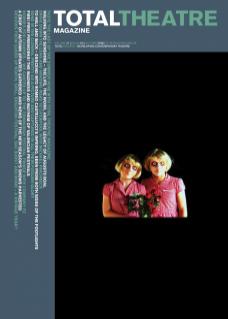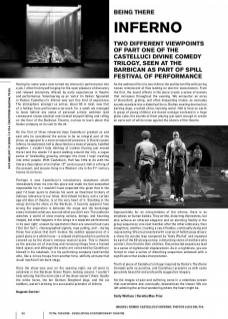Having for some years now turned my interest in performance into a job, I often find myself longing for the open pleasure of discovery and relaxed anonymity offered by early experiences in theatre and performance. Volunteering as an ‘extra’ (in Italian: figurante) in Romeo Castellucci’s Inferno was just this kind of experience. The atmosphere amongst us extras, about 60 in total, was that of a holiday from performance-as-work: for a week we managed to leave behind any sense of personal artistic ambition (and consequent status anxiety) and instead enjoyed falling and rolling on the floor of the Barbican Theatre, curious to learn about this Italian company on its visit to the UK.
On the first of three rehearsal days Castellucci greeted us and said why he considered the extras to be an integral part of the show, as opposed to a mere ornamental presence: in Dante’s poem Inferno, he explained, hell is described as a mass of people, huddled together. I couldn’t help thinking of London (having just moved there) and the weeks I’d spent walking around the city, a vague sense of foreboding growing stronger the more I kept crashing into other people. With Castellucci, Hell has little to do with the literary description of an Italian 13th century poet: Hell is a thing of the present, and anyone living in a Western city in the 21st century knows its tortures.
Perhaps it was Castellucci’s introductory statement which immediately drew me into this piece and made me feel somewhat responsible for it; I wouldn’t have expected this given that in the past I’d been quick to dismiss his work as theatrical trickery of dubious relevance to our times. And indeed trickery, and a certain age-old idea of theatre, is at the very heart of it. Standing in the wings during the show at the Barbican, it became apparent how strong the separation is between the stage and the backstage areas: between what you see and what you don’t see. The audience watches a world of slow moving actions, beings, and haunting images, but what happens in the wings is a separate performance in its own right: unseen by spectators there are several loud cues (‘Go! Go! Go!’), choreographed signals, rope pulling, and – during those few scenes that don’t involve the sudden appearance of a grand piano or a white horse – a relaxed chatting which is perfectly covered up by the show’s ominous musical score. This is theatre as the precise art of inserting and removing things from a framed black space; and although the works are conceived by Castellucci himself in his notebook, it is his performing company (and family) who, like a circus troupe from another time, skilfully activate that visual machine from back stage.
Once the show was over on the opening night, we all went to celebrate in the Barbican Green Room; looking around, I couldn’t help noticing that the main stars of the show weren’t there: Apollo the white horse, the ten German Shepherd dogs, and the six toddlers, weren’t drinking to a successful première of Inferno.
Augusto Corrieri
As the audience file in to see Inferno, the auditorium fills with jarring noises reminiscent of flies landing on electric executioners. From the first, the sound effects in the piece create a sense of anxiety that increases throughout the evening. We encounter an array of discordant, grating, and often disquieting noises, as everyday sounds escalate into a diabolical force. Bodies meeting destruction, barking dogs, crushed china, twisting metal. Hell is here on earth. A group of young children are drawn onstage enclosed in a huge glass cube; the sounds of them playing just quiet enough to create an eerie sort of white noise against the silence of the theatre.
Appropriately for an interpretation of the inferno, there is an emphasis on human bodies. They writhe, distorting themselves, but also achieve an ethereal elegance and an alarming fluidity in the group sequences; one cast member after the other embraces, then slaughters, another, creating a sea of bodies, continually dying and rejuvenating. We are presented with a series of hellish peep shows: a show-biz suicide leap compered by ‘Andy Warhol’ and repeated by each of the 60-strong extras; a disturbing vision of mothers who comfort, then throttle their children. Disconnected sequences lead to a sense of nightmarish displacement. As in a nightmare, you are forced to view a series of disturbing sequences endowed with a significance that eludes interpretation.
The first piece of Castelluci’s trilogy( inspired by Dante’s The Divine Comedy) pulls no punches, and Castellucci presents us with some genuinely beautiful and profoundly suggestive imagery.
Yet the images of pain and suffering come in a relentless stream that overwhelms and, eventually, desensitises the viewer. We are left admiring the art but wondering where the heart might be.
Emily Wallace / Dorothy Max Prior

